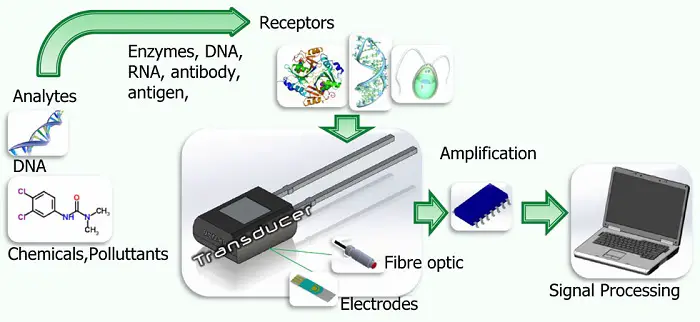Biosensing technology operates based on the principles of detecting and measuring specific biological interactions between a bioreceptor and an analyte and converting these interactions into a measurable signal using a transducer.
Principles of Biosensing Technology
Here are the fundamental principles underlying biosensing technology:
- Biological Recognition: Biosensors utilize a biological recognition element (bioreceptor) that selectively interacts with the target analyte of interest. The bioreceptor can be an enzyme, antibody, nucleic acid, cell, or biomimetic molecule that binds specifically to the target analyte, resulting in a biological response.
- Analyte Binding: When the target analyte binds to the bioreceptor, it changes its conformation, activity, or binding affinity. This binding event is particular, allowing the biosensor to selectively detect and measure the presence of the target analyte in complex samples.
- Transduction: The interaction between the bioreceptor and the analyte generates a biological or chemical signal that needs to be converted into a measurable output signal. This is achieved using a transducer, which converts the biological response into a quantifiable signal, such as an electrical, optical, thermal, or mass-based signal.
- Signal Amplification: In some cases, signal amplification techniques may be employed to enhance the sensitivity and detectability of the biosensor. Amplification strategies include enzymatic reactions, signal amplification cascades, or signal amplification using nanomaterials or signal amplification molecules.
- Signal Detection and Measurement: The output signal generated by the transducer is detected and measured using appropriate instrumentation or detection methods. This may involve electronic sensors, optical detectors, spectroscopic techniques, or imaging systems, depending on the nature of the transducer and the type of signal being measured.
- Data Analysis and Interpretation: The measured signal is processed, analyzed, and interpreted to quantify the concentration or presence of the target analyte. This may involve calibration curves, standard curves, mathematical algorithms, or statistical methods to convert the raw signal into meaningful analytical results.
- Validation and Calibration: Biosensing technology requires validation and calibration to ensure the analytical measurements’ accuracy, reliability, and reproducibility. Validation involves assessing the biosensor’s performance characteristics, such as sensitivity, specificity, precision, and accuracy, under controlled conditions. Calibration involves establishing a relationship between the measured signal and the target analyte concentration using reference standards or calibration samples.
Potential Uses of Bio-sensing Technology in the Veterinary Field
Biosensors have significant potential applications in veterinary science, offering versatile tools for disease diagnosis, monitoring animal health, ensuring food safety, and improving agricultural productivity. Here are some potential uses of biosensors in veterinary science:
- Disease Diagnosis and Monitoring: Biosensors can be used for the rapid and accurate diagnosis of infectious diseases in animals. They enable the detection of pathogens, such as bacteria, viruses, and parasites, in clinical samples (e.g., blood, saliva, feces) from animals. Biosensors offer high sensitivity and specificity, allowing for early detection of diseases and timely interventions to prevent disease spread and improve animal welfare.
- Point-of-Care Testing: Biosensors enable point-of-care testing (POCT) for veterinary diagnostics, providing rapid on-site detection of animal diseases. Portable biosensing devices allow veterinarians to perform diagnostic tests in the field or on the farm without requiring specialized laboratory equipment or trained personnel. POCT with biosensors facilitates quick decision-making, treatment planning, and disease management in veterinary practice.
- Monitoring of Animal Health and Welfare: Biosensors can be used for continuous monitoring of animal health parameters, such as biomarkers of stress, inflammation, metabolic disorders, and reproductive status. Wearable biosensors attached to animals (e.g., collars, ear tags, implantable devices) enable real-time monitoring of physiological parameters, activity levels, and behavioral patterns, providing insights into animal health and welfare in livestock production systems.
- Detection of Veterinary Drug Residues: Biosensors detect residues of veterinary drugs and antibiotics in animal-derived products, such as meat, milk, and eggs. They enable rapid screening of food samples for drug residues, ensuring compliance with food safety regulations and preventing human exposure to harmful residues.
- Food Safety and Quality Assurance: Biosensors play a critical role in ensuring the safety and quality of animal-derived food products. They enable the detection of foodborne pathogens, toxins, allergens, and contaminants in animal feed, raw materials, and finished products. Biosensors facilitate rapid screening of food samples for microbial contamination and chemical residues, supporting food safety assurance and public health protection.
- Livestock Management and Production Optimization: Biosensors are used for monitoring parameters related to livestock management and production optimization, such as feed intake, nutrient metabolism, milk yield, and reproductive performance. Biosensors provide real-time data on animal physiology and behavior, allowing farmers to make informed feeding, breeding, and health management decisions to maximize production efficiency and profitability.
Overall, biosensors offer versatile and valuable tools for disease diagnosis, monitoring animal health, ensuring food safety, and improving agricultural productivity in veterinary science. By providing rapid, sensitive, and specific detection of analytes in diverse applications, biosensors enhance animal health and welfare, optimize livestock production systems, and safeguard public health.
Conclusion on Biosensing Technology
Biosensing technology relies on specific biological recognition, signal transduction, signal amplification, signal detection, and data analysis to detect and measure target analytes with high sensitivity, selectivity, and accuracy. By harnessing these principles, biosensors offer versatile tools for various applications in healthcare, environmental monitoring, food safety, agriculture, and biotechnology.
